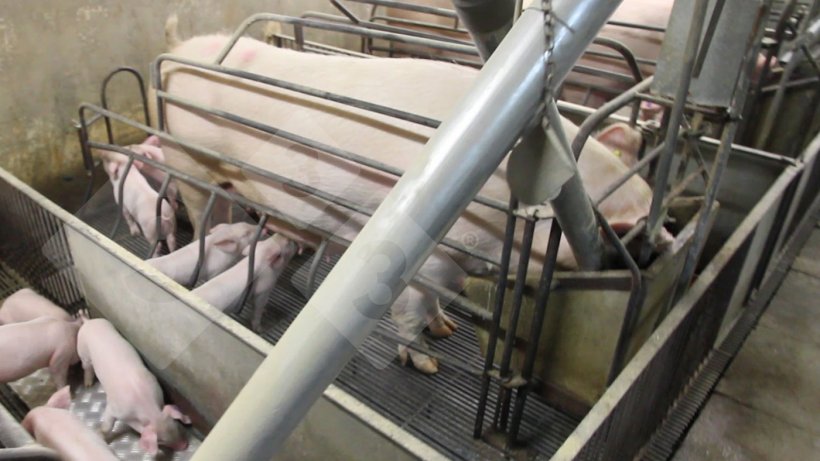Heat stress, intensified by climate change, significantly decreases feed intake in lactating sows, affecting their welfare, milk production, and reproductive performance. This reduction in energy intake forces them to mobilize body reserves. To mitigate these effects, strategies such as diets with a less thermogenic effect or adjustments in feeding schedules to avoid the hottest hours are proposed. Thus, two independent trials were conducted under controlled conditions to evaluate the impact of different nutritional strategies (normal diet and less thermogenic diet) and feeding management in lactating sows exposed to chronic (T1) or acute (T2) heat stress.


Materials and methods
A total of 144 sows (Large White × Landrace) were used, distributed in six groups of 24 animals each. The study was divided into two trials:
- Trial 1 (T1): sows were subjected to chronic heat stress (constant 25 °C) for the entire lactation period, which lasted 28 days.
- Trial 2 (T2): the feeding strategies were not applied for the entire lactation period; instead, they were adjusted according to temperature conditions.
At the beginning of T2, all sows received the TEM treatment. Then, depending on the weather, different strategies were applied: if high temperatures were expected and the room reached 25°C, the feeding was modified starting at 5:00 p.m. and maintained throughout the heat wave, even for two or three more days. When the heat wave ended, the normal treatment (TEM) was used again until extreme temperatures returned.
The treatments evaluated were:
- Treatment 1 - TEM: Standard diet (9.5 MJ NE/kg; 73.6% NE/ME)
- Treatment 2 - ALI: Less thermogenic diet (10.3 MJ NE/kg; 76.3% NE/ME)
- Treatment 3 - DIS: TEM diet, fed avoiding the hottest times of the day.
Feed and net energy intake, weight loss, backfat thickness (BFT), longissimus dorsi muscle thickness (LDT), litter growth, and consumption distribution were measured at each feeding time.
Results
Chronic stress (T1): Sows in the ALI treatment consumed more NE (61.3 MJ/d) compared to DIS (49.7 MJ/d) and TEM (51.4 MJ/d) (P=0.001). This higher intake in ALI also reduced longissimus dorsi muscle loss (LDT: -2.8 mm, equivalent to -3%) compared to DIS (-9.2 mm, -15%) and TEM (-7.1 mm, -11%) (P=0.007), without significantly affecting weight loss or backfat.
Acute stress (T2): Sows in the ALI (60.3 MJ/d) and DIS (57.0 MJ/d) treatments consumed more NE than TEM (48.5 MJ/d) (P=0.004). Dry matter intake was also higher in ALI and DIS (P=0.004). However, there were no significant differences in the mobilization of body reserves (live weight, longissimus dorsi muscle, and backfat thickness) between groups. Sows in the DIS treatment shifted part of their intake to cooler hours during heat waves.
Piglet performance did not differ between treatments in either trial.
Table 1: Summary of key sow performance outcomes.
| Parameter | T1 (Chronic stress) |
T2 (Acute stress) |
||||
|---|---|---|---|---|---|---|
| TEM | DIS | ALI | TEM | DIS | ALI | |
|
Dry matter intake |
5.41a | 5.23a | 5.95b | 5.11a | 6.00b | 6.10b |
|
Net energy intake |
51.4a | 49.7a | 61.3b | 48.5a | 57.0b | 60.3b |
|
Longissimus dorsi muscle thickness loss (LDT), % |
-11a | -15a | -3b | -15 | -9 | -10 |
|
Live weight loss |
-16 | -15 | -13 | -16 | -13 | -14 |
|
Backfat thickness loss  |
-23 | -25 | -21 | -27 | -24 | -23 |
Abbreviations: TEM=Control, DIS=TEM with ration fed at different times, ALI=Less thermogenic diet. LDT=Longissimus dorsi muscle thickness, LW=Live weight, BFT=Backfat thickness. Different letters
(a, b) in the same row and within the same trial indicate significant differences (P<0.05 or P<0.01 according to the original article). Values without letters for LDT, LW, and BFT in Trial 2 showed no significant differences (P > 0.05).
Discussion
The study confirms the negative impact of both chronic and acute heat stress on feed intake in lactating sows and validates nutritional and management strategies to mitigate it. The conclusion on the effect of heat stress on feed intake was based on the comparison of litter growth with that observed during other seasons, as no sows under thermoneutral conditions were included in this study.
The less thermogenic diet (ALI) consistently increased NE intake under both stress conditions, helping preserve longissimus dorsi muscle during chronic stress.
On the other hand, modification of the feeding schedule (DIS), by avoiding the hottest hours of the day, increased NE intake only during heat waves (acute stress), with no effect under chronic stress conditions. This suggests that the benefit of schedule adjustment is greatest when heat stress is transient, as it facilitates shifting intake to cooler periods of the day.
In conclusion, both strategies are valid tools. The less thermogenic diet (ALI) offers more consistent benefits under different heat stress scenarios. Modifying schedules (DIS) is effective against specific heat waves, but its implementation depends on having sufficiently flexible feeding systems. The choice between the different strategies will depend on the prevailing type of heat stress and the farm infrastructure.
Content prepared by 333 editorial staff, as a summary of “Suffit-il d'utiliser un aliment moins thermogène ou d'éviter la distribution de repas pendant les heures les plus chaudes de la journée pour améliorer l'ingéré énergétique de la truie allaitante exposée à un stress thermique chronique ou ponctuel ?”
Nathalie QUINIOU (1), Julie DUPUIS (1), David RENAUDEAU (2)
(1) IFIP - Institut du Porc, 9 Boulevard du Trieux, 35740 Pacé, France
(2) PEGASE, INRAE, INSTITUT AGRO, 16 Le Clos, 35590 St-Gilles, France




